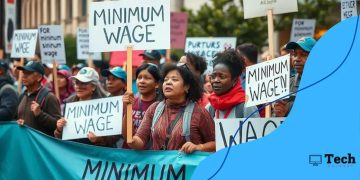Anti-corruption reform protests: What you need to know

Anti-corruption reform protests aim to challenge corrupt practices, demand accountability, and promote transparency through grassroots activism and the strategic use of social media.
Anti-corruption reform protests are becoming a powerful force in advocating for change. Have you noticed how these movements rally diverse groups to challenge corruption? Let’s dive into their dynamics and implications.
Understanding the roots of anti-corruption movements
Understanding the roots of anti-corruption movements is vital for grasping their current significance. These movements arise in response to widespread dissatisfaction with corrupt practices that undermine social justice and economic equity.
In the past few decades, many countries have experienced waves of protests driven by public anger over corruption. It often stems from a sense of betrayal when leaders fail to act transparently. As people become aware of abuses of power, they feel compelled to take action.
The historical context of corruption
Corruption doesn’t happen overnight; its roots often lie deep in history. In many nations, a legacy of poor governance contributes to present-day challenges. Understanding this timeline is key to recognizing how movements gain momentum.
- Colonial legacies that fostered inequality.
- Weak institutions leading to a lack of accountability.
- Economic disparities that fuel frustration.
When analyzing these historical factors, it’s crucial to note how cultural attitudes towards authority might also play a role. In societies where corruption is normalized, challenging the status quo can seem daunting.
The role of grassroots organizations
Grassroots organizations often play a huge part in mobilizing community support against corruption. These groups act as a bridge, connecting citizens’ grievances to broader national and global movements. They provide education, rally support, and bring awareness to local issues. When individuals unite, they amplify their voice against corrupt systems.
- Building local knowledge about rights and responsibilities.
- Fostering community solidarity and resilience.
- Creating networks that extend beyond local contexts.
Moreover, the power of social media has dramatically shifted the landscape. These platforms allow activists to share their stories, mobilize citizens quickly, and garner international support. Social media serves as a tool for transparency, helping to expose corruption and rallying supporters despite governmental pushback.
Key events that sparked recent protests
Several key events have ignited recent protests against corruption around the globe. Each event has acted as a catalyst, mobilizing citizens to demand transparency and accountability from their leaders.
One significant example was the exposure of high-profile corruption cases that shook entire nations. When details emerged about politicians embezzling public funds, public outrage skyrocketed. This was especially true in countries where trust in government was already low.
The impact of whistleblowers
Whistleblowers play a crucial role in bringing corruption to light. Their bravery leads to investigations and sparks conversations among citizens. This encourages more people to join the fight against corrupt practices.
- Whistleblowers can reveal hidden abuses of power.
- They often provide evidence that leads to legal action.
- Public support for whistleblowers can grow, as seen in many recent cases.
Another pivotal moment occurred during widespread economic crises. When people struggle daily and government responses appear inadequate, protests erupt. Citizens become frustrated with corrupt negotiations that favor the few over the many, and they take to the streets to demand change.
Social media’s role in organizing protests
Social media platforms have changed how people organize and share information about anti-corruption protests. They provide a space for citizens to voice concerns and unite for a common cause. Hashtags often trend during protests, amplifying messages and drawing in international attention.
- Social media helps to inform people about upcoming protests.
- It can highlight specific cases of injustice.
- Engagement online fosters community support.
Additionally, the visual power of images captured during these events plays a significant role. Viral photos can galvanize support, even across borders. Watching fellow citizens stand up against injustice can inspire similar actions elsewhere, leading to a chain reaction of protests.
The role of social media in mobilization

The role of social media in mobilization has transformed how protests occur and spread. Platforms like Twitter, Facebook, and Instagram allow people to share information rapidly and connect with others who share similar concerns.
When protests arise, social media often serves as the first point of contact for organizers. This facilitates quick mobilization as users spread the word about events and create online communities. The immediacy of these platforms helps keep the momentum alive.
Key functions of social media in protests
There are several key functions that social media serves in the context of anti-corruption protests. Understanding these can highlight its importance:
- Spreading awareness: Through posts, videos, and live streams, activists can showcase their cause.
- Engagement: Social platforms create opportunities for discussion, allowing citizens to voice their opinions and strategies.
- Networking: Activists can connect with organizations, resources, and individuals across the globe.
Another significant aspect is the ability of social media to capture and share moments in real time. Pictures and videos can go viral, leading to increased visibility and support. This can attract attention from international media and human rights organizations.
Challenges of social media in mobilization
However, there are challenges to consider as well. Misinformation can spread just as quickly as the truth. False narratives can undermine actual movements and create confusion among participants. Moreover, oppressive regimes may monitor social media to suppress dissent.
- Ensuring accurate information is vital for credibility.
- Users must be aware of potential surveillance.
- Online threats may lead to offline consequences, affecting participants’ safety.
Despite these challenges, the power of social media in organizing protests cannot be overstated. It provides a vital tool for communities to mobilize, raise their voices, and demand change in a corrupt world.
Global responses to anti-corruption reform protests
Global responses to anti-corruption reform protests vary widely, influenced by the political, social, and economic contexts of each country. In some instances, governments embrace reform, while in others, they resort to suppression.
When protests gain international attention, foreign governments and organizations often respond. They may offer support to reform movements or condemn the repression of peaceful demonstrations. Such reactions can amplify the protests’ impact and encourage local activists.
Support from international organizations
International organizations play a significant role in advocating for reforms. Institutions like the United Nations and Transparency International often call for accountability and transparency. They provide resources and expertise to nations striving to combat corruption.
- They issue reports highlighting corrupt practices.
- They facilitate dialogue between local leaders and global experts.
- They support funding for anti-corruption initiatives.
In some cases, countries facing severe backlash from their citizens experience sanctions or diplomatic pressure from other nations. Such actions can influence governments to reconsider their approaches to corruption.
Public opinion and its effects
The global public also plays a role in shaping responses to these protests. Social media campaigns can elevate issues to international prominence, compelling governments to act. Citizens worldwide often express solidarity with protesters, creating a worldwide push for reform.
- These movements can influence voting behavior in countries with international agendas.
- Increased awareness can lead to global fundraisers and advocacy efforts.
- Public demonstrations in support of anti-corruption movements can emerge in various nations.
Ultimately, the interplay of local protests and global responses demonstrates the interconnected nature of today’s activism. As citizens rise against corruption, their efforts resonate beyond borders, promoting a collective call for change.
Future outlook for anti-corruption initiatives
The future outlook for anti-corruption initiatives appears promising, as citizens worldwide are increasingly demanding integrity and transparency from their leaders. As awareness of corruption grows, so does the push for reform and accountability.
One key factor that will shape these initiatives is the continued development of technology. Digital tools and platforms can enhance transparency, making it easier to track government spending and hold officials accountable. These innovations can empower citizens to demand change.
The role of education
Education plays a crucial role in fostering a culture of accountability. By raising awareness about corruption’s effects, citizens become more inclined to participate in reform efforts. Schools and community programs that focus on civic engagement can inspire the next generation to advocate for integrity.
- Promoting ethical behavior starting from a young age.
- Teaching citizens about their rights and responsibilities.
- Encouraging proactive participation in governance.
Moreover, collaboration among nations will be instrumental in combating corruption. Countries sharing best practices and resources can strengthen their fight against corrupt practices. International partnerships can lead to more effective legislative frameworks and enforcement actions.
The impact of grassroots movements
Grassroots movements will also play a significant role in shaping the future of anti-corruption efforts. As more people unite to demand change, their collective power can influence policy decisions. These movements can adapt quickly to changing circumstances, ensuring that the fight against corruption remains relevant and impactful.
- They can respond to emerging corruption cases swiftly.
- Community leaders can mobilize support for targeted campaigns.
- Coalitions can form across borders to strengthen calls for accountability.
In summary, the future of anti-corruption initiatives depends on a combination of technological advancements, education, global cooperation, and grassroots activism. As all these elements come together, the potential for significant change becomes increasingly attainable.
FAQ – Frequently Asked Questions about Anti-Corruption Protests
What are anti-corruption protests?
Anti-corruption protests are public demonstrations aimed at opposing corrupt practices and demanding greater transparency and accountability from governments and institutions.
How can social media influence anti-corruption movements?
Social media allows activists to organize, share information quickly, and mobilize support, amplifying the reach and impact of their messages.
What role do grassroots organizations play in these protests?
Grassroots organizations help mobilize local communities, raise awareness, and connect citizens with a broader movement for change.
Why is international support important for anti-corruption initiatives?
International support can provide resources, best practices, and pressure on governments to implement reforms, helping to strengthen local movements against corruption.






